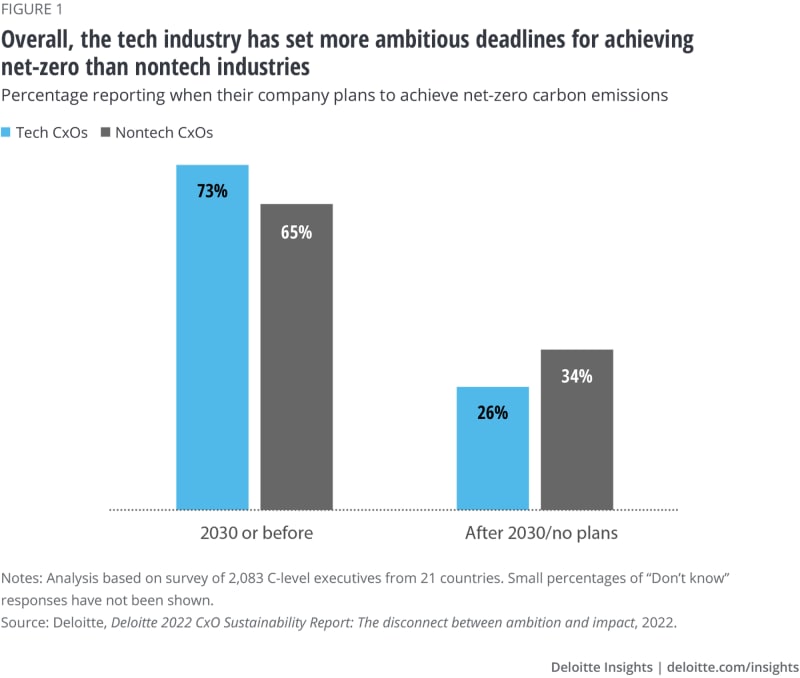The United Nations describes “net zero” as “cutting greenhouse gas emissions to as close to zero as possible, with any remaining emissions re-absorbed from the atmosphere, by oceans and forests for instance.” See: United Nations, “For a livable climate: Net-zero commitments must be backed by credible action,” accessed August 11, 2022.
View in ArticleDeloitte, Deloitte 2022 CxO sustainability report: The disconnect between ambition and impact, 2022.
View in Article- It’s not entirely clear why tech leaders are more likely to report being personally affected by adverse climate-change events. Geographic location and greater familiarity with climate-change concepts may both play a role.View in Article
Chris Stokel-Walker, “Data centers are facing a climate crisis,” Wired, August 1, 2022.
View in ArticleLaura He, “China’s worst heatwave in 60 years is forcing factories to close,” CNN Business, August 17, 2022.
View in ArticleSebastian Moss, “How California's wildfires took down a supercomputer,” DCD Magazine, January 17, 2020.
View in ArticleJacques Leslie, “How climate change is disrupting the global supply chain,” YaleEnvironment360, March 10, 2022.
View in ArticleAddisu Lashitew, "The coming of age of sustainability disclosure: How do rules differ between the US and the EU?," Brookings, June 6, 2022; Emily Abraham et al., “Executive summary of the SEC’s proposed rule on climate disclosure requirements,” Deloitte, Heads Up, Volume 29, Issue 2, March 21, 2022; Veronica Poole and Kristen Sullivan, Tectonic shifts: How ESG is changing business, moving markets, and driving regulation, Deloitte Insights, October 29, 2021; Gina Miani et al., "The ESG regulatory whirlwind: Accountability on the horizon," Deloitte, June 4, 2021.
View in ArticleDeloitte 2022 CxO sustainability report.
View in ArticleThe SBTi is a collaboration between CDP, the United Nations Global Compact, World Resources Institute (WRI) and the World Wide Fund for Nature (WWF). See: "About Us: Science Based Targets initiative (SBTi)," SBTi, accessed August 5, 2022. The first step in working with the SBTi is to submit a letter of intent to set a science-based target. Then, a company works with the SBTi to develop and validate emissions targets. See: “How it works: Science Based Targets,” SBTi, accessed August 12, 2022.
View in ArticleDeloitte analysis of SBTi data in mid-August 2022 revealed that the sector with the most signatories—395—is Agriculture (including food and beverage manufacture and stores, as well as forestry and paper products). The Technology sector has 338 signatories, followed by Professional Services with 303. If technology, media, and telecommunications are considered as a single sector, they represent the largest grouping, with 485 signatories.
View in ArticleGoogle has said that it has already achieved net-zero emissions; Amazon, Apple, Facebook, and Microsoft have announced plans to reduce their emissions to net zero. See: Tim Quinson, “Tech firms are setting the most ambitious net-zero goals,” Bloomberg, April 7, 2021. Some tech companies have committed to work toward net-zero carbon through The Climate Pledge, co-founded by Amazon, or individual efforts, such as Apple’s pledging to become carbon-neutral across its businesses by 2030. See: The Climate Pledge, “The pledge commitments,” accessed August 8, 2022; Apple, “Apple commits to be 100 percent carbon neutral for its supply chain and products by 2030,” press release, July 21, 2020. Deloitte TMT Predictions is an independent publication and has not been authorized, sponsored, or otherwise approved by Apple Inc.
View in ArticleJustine Calma, “Big Tech drove record clean energy purchases in 2021,” The Verge, February 1, 2022; BloombergNEF, “Corporate clean energy buying tops 30GW mark in record year,” press release, January 31, 2022; Sam Schechner, “Amazon and other tech giants race to buy up renewable energy,” Wall Street Journal, June 23, 2021.
View in ArticleOne likely reason is to retain access to capital. A considerable portion (more than US$60 trillion) of the world’s total investment assets are under management by Climate Action 100+, an initiative comprising 617 global investors that have committed to invest responsibly. See: Tim Mohin, “Why are big tech companies asking for climate regulation?,” Fast Company, May 18, 2021. Another likely reason is a desire for greater regulatory certainty. See: Justine Calma, "Tech giants call on SCOTUS to let EPA regulate CO2 emissions," The Verge, January 26, 2022.
View in ArticleUnited Nations Environment Programme (UNEP), “With new pact, tech companies take on climate change,” March 19, 2021; Cliff Saran, “COP26: IT’s role in tackling climate change,” Computer Weekly, October 25, 2021.
View in ArticleThe tech sector is estimated to be responsible for a far smaller share of world’s greenhouse gas emissions than other sectors, such as agriculture and transportation. See: UNEP, “With new pact, tech companies take on climate change;” Hannah Ritchie et al., "CO₂ and greenhouse gas emissions," OurWorldInData.org, accessed August 22, 2022.
View in ArticleAmazon, "Amazon extends position as world’s largest corporate buyer of renewable energy," April 20, 2022, accessed August 23, 2022; Jenny Darmody, "Apple invested in 17 renewable energy projects in 2020," Silicon Republic, March 18, 2021; Apple, Annual Green Bond Impact Report: Fiscal Year 2021 Update, 2021; Google Cloud, "24/7 Carbon-free energy: Powering up new clean energy projects across the globe," accessed August 23, 2022; Meta, 2021 Sustainability report, May 2021; Meta, "Map—Meta sustainability," accessed August 23, 2022; Microsoft, 2021 Environmental sustainability report, 2021.
View in ArticleBen Lovejoy, “Apple supply chain doubled its use of clean energy last year, en route to 2030 commitment,” 9to5Mac, April 14, 2022; Adele Peters, “Apple invested in this solar farm to help clean up your power use at home,” Fast Company, April 14, 2022.
View in ArticleMaria Deutscher, "Amazon announces London micromobility hub and new solar installations," SiliconAngle, July 4, 2022.
View in ArticleCatherine Clifford, "How Google plans to use 100% carbon-free energy in its data centers by 2030," CNBC, April 13, 2022; Ross Koningstein, "We now do more computing where there’s cleaner energy," Google blog, May 18, 2021; Michael Terrell, "With new geothermal project, it’s full steam ahead for 24/7 carbon-free energy," Google Cloud blog, May 18, 2021.
View in Article- Amazon, “The Climate Pledge | Signatories,” accessed September 26, 2022.View in Article
Kimberley Botwright and James Pennington, “Will your next phone be made from recycled materials? These 6 tech giants are working on it,” World Economic Forum, September 24, 2020; Kelly MacNamara, “Big tech backs plan to tackle e-waste crisis,” Tech Xplore, March 18, 2021; Michael Murphy, “Electronics can trigger a more circular, sustainable world—here’s how,” World Economic Forum, May 12, 2021.
View in ArticleDell Technologies, “How we developed our most ambitious Advancing Sustainability 2030 goals,” accessed August 8, 2022.
View in ArticleLloyd Alter, "Apple gets first commercial-grade low-carbon aluminum from Elysis," Treehugger, April 1, 2022.
View in ArticleJames Temple, “Half of the world’s emissions cuts will require tech that isn’t commercially available,” MIT Technology Review, May 18, 2021.
View in Article- BloombergNEF, “Tech giants launch emissions tracking tools for Scope 3,” April 7, 2022.View in Article
Catherine Clifford, “Stripe teams up with major tech companies to commit $925 million toward carbon capture,” CNBC, April 12, 2022.
View in ArticleNick Statt, “Google and DeepMind are using AI to predict the energy output of wind farms,” The Verge, February 26, 2019.
View in ArticleInternational Telecommunication Union (ITU), Turning digital technology innovation into climate action, September 29, 2020; Börje Ekholm and Johan Rockström, “Digital technology can cut global emissions by 15%. Here’s how,” World Economic Forum, January 15, 2019; Mai Tao, “7 supply chain technology trends shaping a sustainable future,” Robotics & Automation News, April 7, 2021.
View in ArticleVodafone, “Helping society to decarbonize,” accessed August 23, 2022.
View in ArticleScott Corwin and Derek M. Pankratz, Leading in a low-carbon future: A “system of systems” approach to addressing climate change, Deloitte Insights, May 24, 2021.
View in ArticleAccording to the US Environmental Protection Agency, about 12% of GHG emissions in the information technology sector are due to operations, and 88% are due to value chains. See: Center for Corporate Climate Leadership, Emerging trends in supply chain emissions engagement, Environmental Protection Agency, June 2018.
View in ArticleDeloitte, “Tackling your value chain emissions: Why reducing your Scope 3 emissions is vital to reaching net zero,” accessed August 23, 2022.
View in ArticleCorwin and Pankratz, Leading in a low-carbon future; Andy Marks, “A business blueprint for a low-carbon future,” CIO Journal, November 2, 2021.
View in Article


















